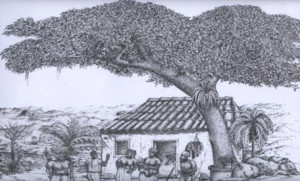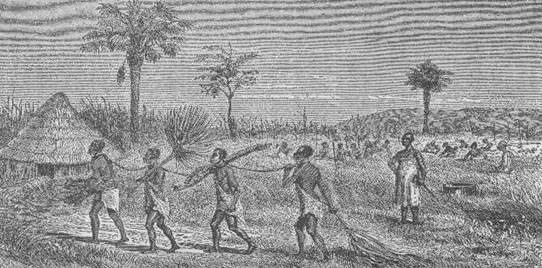 The Quilombo comes from Bantus tribes. It’s a brazilian version of the African Quilombo, which appeared in Angola at XVII and XVIIIth centuries. The word Quilombo is a Portuguese adaptation of Kilombu, language of Quimbundo, which means village or camp. Most of Black Brazilians are descendants of Angolan people.
The Quilombo comes from Bantus tribes. It’s a brazilian version of the African Quilombo, which appeared in Angola at XVII and XVIIIth centuries. The word Quilombo is a Portuguese adaptation of Kilombu, language of Quimbundo, which means village or camp. Most of Black Brazilians are descendants of Angolan people.
Black people re-created in Brazil the Angolan social structures they knew at the time in Africa.
The Quilombo was introduced in Angola by Imbangalas herds, who entered the Mbundu territories, mixing themselves with natives and giving birth to the Ngola kingdom.
The legendary Queen Ginga adopted Jagas war strategies, invincible war machines and slaves trade.
Cities were simple built-up areas of huts, called Libata or Quilombo, inspired by antic Roman camps. The word Libata has been invented at the time by Portuguese people. The Quilombo was dominated by a potentate. Its population lived in houses easy to build up and to convey, gathered in big districts, headed by a chief. At the centre of the Quilombo, there was the chief’s house, the lord of the camp, who was a wealthy and powerful man, a slaves’ owner. The Quilombo was surrounded by solid fences, shaped in a labyrinth to make the access hard for strangers. A Quilombo counted more or less one thousand inhabitants. The succession was not hereditary. The choice of the leader depended on his experience and reputation.
The Jagas were an ethnic mix which represented 16000 warriors. The army’s size had increased with prisoners, submitted to temporary slavery, who could become free men by proving their bravery and value in fighting.

In each conquered region, Jagas adopted people languages. The Angolan Quilombo played a major part in slaves’ trade. Brazilian Quilombos were a rampart, a struggle and a resistance against slavery in Brazil.
The most famous Quilombo in Brazil was Palmares. It constituted an answer of the slaves to the special conditions of Brazilian slavery. Black people built in time and space their own villages in whole South America. Tribal regression movements were based in African culture. Palmares poyandry was a remains of African matriarchy, the reproduction of a political system which existed in antic Africa.




